The Bark River Snowy River has proven to be a stellar performer as a hunting knife.
by Leon Pantenburg
(Disclaimer: Kniveshipfree.com is a Survivalcommonsense sponsor, but they did not supply a free knife. Neither KSF nor Bark River Knives had any input into this review.)
There was about half an hour of daylight left before the sun would set. The temperature was below freezing and dropping rapidly. It was snowing sideways on a cold, blustery January evening in Oregon’s Wallowa Mountains. Dr. Patrick Simning was hunting alone, and had just killed a cow elk as part of a depredation hunt.
At times like this, you don’t want a knife with mediocre steel that requires a lot of sharpening. Pat used his Bark River Snowy River exclusively to gut the elk, and later to skin it out.
I regularly do out-of-the-box knife reviews to show the finish, design, and fit of the handle. And they’re valuable – you need some basic info about a knife before investing in it. But the proof is in the pudding. How does the knife really work under the field conditions for which it was designed? And how does it hold up to extended use? Should you invest your hard-earned cash in an expensive knife as part of your preparedness/hunting/survival gear?
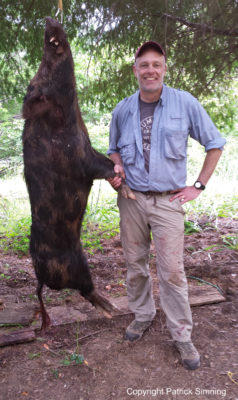
Pat and one of the hogs his Snowy River was used on.
To do a thorough knife review, I’ll sometimes loan or give a knife to someone who will use it. (Good friends should have good knives!)
Here are my rules for guest field testing:
- No knife is too pretty to get used hard.
- The knife will not be routinely abused, but will receive normal use for the purpose it was intended.
- All reservations about the knife will be mentioned.
- I do the sharpening, so I can see how the edge holds up. (Actually, I do most of the sharpening in our hunting group anyway. I enjoy it!)
Here is how the Snowy River review started. I killed a bull elk on Nov. 11, 2015 and Pat and I were wielding knives as we field dressed it. I asked Pat to try out a Snowy River, because it resembled one of Pat’s user knives, a Mora 840 Companion.
Pat is on my short list of hunting companions. A former scoutmaster and Navy physician who served 13 years with the U.S. Marines, Pat has above-average knife handling skills. We are both Boy Scout volunteers, and have been on many, many campouts and outings together with our sons. (It’s very comforting to have a doctor along in the back country!) And while Pat’s favorite knife is a beautiful Damascus custom, his user was generally a Mora.
Anyway, I was using an Ambush Tundra, and Pat could have tried it or a Sahara, Kalahari or Bravo LT. But he latched on to the Snowy River immediately, and never let go. We took the bull back to Pat’s house to skin it out, and Pat used the Snowy River exclusively. Since then, Pat has used that Snowy River a lot.
Here are the Snowy River specs, courtesy of KnivesShipFree:
| Overall Length: | 8.125″ |
| Blade Length: | 3.775″ |
| Cutting Edge Length: | 3.6″ |
| Blade Height: | 0.89″ |
| Blade Steel: | Elmax stainless @ 60-61 RC |
| Blade Thickness: | 0.156″ |
| Weight: | 4.125oz. |
| Price: | Starting at $217.47 |
Here’s the update on the Snowy River.
Steel: The Snowy River was my first experience with Elmax, sometime referred to as a “super stainless steel.” The Elmax in Pat’s Snowy River never lost its user edge.
Pat used the Snowy River to help skin and gut my elk, another spike elk, two hogs and a cow elk without ever sharpening it! The blade was far from dull when I got hold of it recently, and it could easily have processed another deer. But as part of my obsessive-compulsive need to sharpen knives, I wanted to check out the Elmax. (See Rules for field testing.)
I started with KSF black compound on a leather strop, followed with the finer green, and finished off with stropping the edge on smooth leather. I don’t use or need a whetstone on convex grind blades.
The blade went from sharp to scary, wicked, almost dangerous, sharp with very minimal effort on my part. Based on this very limited experience, I’d have to say that the Elmax holds an edge very well under field use and is not difficult to sharpen.
My experience has been that with the A2, CPM 3V and Bohler N661 “super steels,” resharpening in the field is generally not necessary. I have completely processed a buck deer with my Sahara in A2 steel without the blade needing any touch up, and the same experience was true with CPM 3V.
In the old days, before I could afford high quality knives, I routinely carried sharpening tools as part of my hunting daypack. Not anymore.
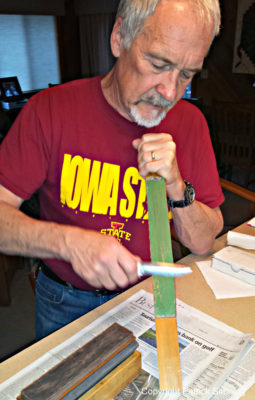
A quick stropping restored the razor edge on the Snowy River. While I was at it, I sharpened all the Simnings’ kitchen knives.
Handle fit: The Snowy River handle fits my hand fine, though my fingers are a little crowded. Pat’s hands are smaller, and subsequently, the handle fits him really well.
Probably the most dangerous part of field dressing a deer or big game animal is when you are using the knife inside the abdominal cavity. Chances are, there will be a lot of blood and possibly pulverized heart and lung tissue. You may have to dip the knife and your hand into this slurry to cut the esophagus, and the diaphragm that separates the lungs from the viscera. You definitely want a well-designed, secure handle that fits your hand.
Handling: Pat had an elk to field dress by himself. At times like that, knife cost is not a consideration, and the only concern is if the tool is going to work for the job.
The Snowy River proved itself again on wild hogs. Deer are thin skinned, and relatively easy on an edge. Elk have thicker, tougher hides and hair, and dull a knife quicker.
Hogs are tough. They have a thick, almost armor-like skin, Pat said, and the hide is frequently covered with dirt and mud. An edge that will hold up under those conditions is a definite keeper.
If the Snowy River had not proven itself as a user, you can bet Pat would have gotten another hunting knife.
Grind: The Snowy River has a convex grind, and to my way of thinking, that is the best choice for a hunting knife. As I’ve mentioned before in other posts, I tried out three different grinds on the same elk carcass, and the convex ended up as the best skinner.
Pat agrees.
Blade design: The Snowy River has a drop point with swedge. In Pat’s opinion, that is about ideal for a hunting knife. I prefer a clip point with a swedge, but that’s not a deal breaker on a hunting knife for me. (Check out Pat’s book)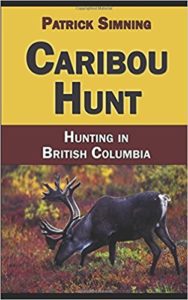
Blade length: Pat prefers a four-inch blade for most of his hunting needs. Considering he also successfully hunts moose and caribou, his choices are well proven. I like to go with a blade that is between four and five inches long. My go-to Tundra has a 4.5-inch blade.
Sheath: Pat and I both carry our knives in a daypack. The Snowy River comes with a solid leather sheath that secures the knife safely and well. If you choose to carry the knife on a belt, or lashed to a pack frame the sheath will do its job just fine.
Good friends should have good knives, in case you ever need to borrow one. And I think Pat is sticking with the Snowy River. As he said, “It’s an incredible knife!”
Please click here to check out and subscribe to the SurvivalCommonSense.com YouTube channel – thanks!

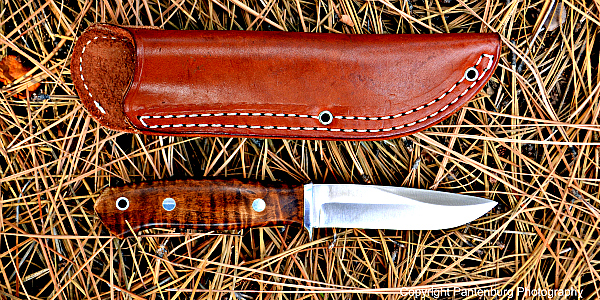
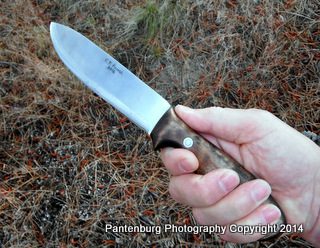
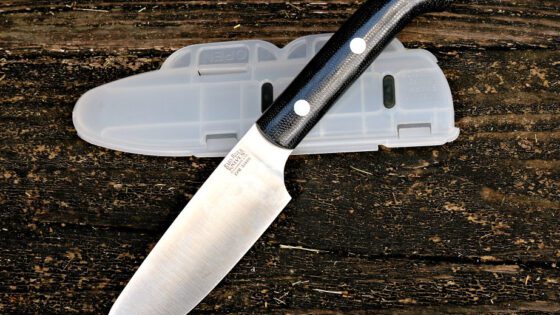
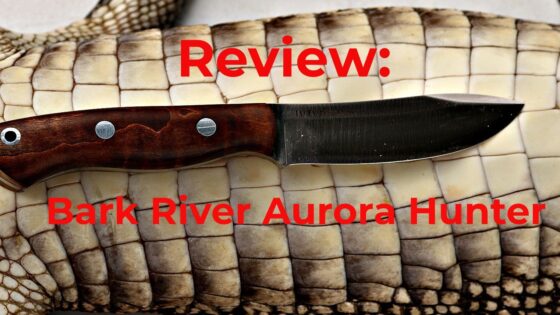
Leave a Reply